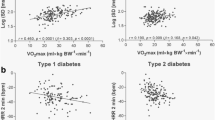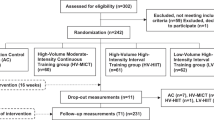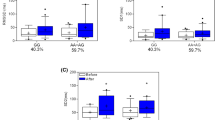Abstract
Considering that changes in exercise routines might have relevance in treatment of adolescents with type 1 diabetes mellitus, we sought to assess whether spontaneous modifications to weekly exercise habits might occur in these patients and whether such variations would be accompanied by alterations in autonomic profile. In this observational study, we examined 77 patients (age 15.0 ± 0.6 years.) who in addition to a tailored optimal insulin treatment were invited to perform at least 1 h a day of moderate, aerobic exercise, as suggested by recent guidelines. Patients were studied at baseline (T0) and after 15.8 ± 0.7 months (T1). They were divided into three subgroups according to increased, unchanged and diminished total estimated weekly METs between T0 and T1. Autonomic profile was evaluated by assessing spontaneous baroreflex gain and low-frequency oscillation in arterial pressure, using spectral analysis of RR and systolic arterial pressure time series. Insulin therapy and biochemical data were similar among the 3 groups at T0 and T1, while body mass index standard deviation score was slightly reduced (p < 0.04) and markers of autonomic performance were improved (alpha index, from 17 ± 1 to 20 ± 2 ms/mmHg, p < 0.002) in the group who increased the amount of exercise (from 1627 ± 250 to 3582 ± 448 METs min wt−1, p < 0.001). Furthermore, the change in total weekly METs significantly correlates with changes of key indices of autonomic regulation. The favourable autonomic effects of moderate increase in spontaneous exercise load suggest testing more formally this intervention in adolescents with type 1 diabetes.

Similar content being viewed by others
Abbreviations
- BRS:
-
Baroreflex gain
- CSII:
-
Continuous subcutaneous insulin infusion
- HFRR :
-
High-frequency components of RR interval
- LFRR :
-
Low-frequency components of RR interval
- LFSAP :
-
Low-frequency component of systolic arterial pressure oscillations
- MDI:
-
Multiple daily insulin injections
- SAP:
-
Systolic arterial pressure
References
Daneman D (2006) Type 1 diabetes. Lancet 367:847–858
Salem M, Moneir I, Adly AM, Esmat K (2011) Study of coronary artery calcification risk in Egyptian adolescents with type 1 diabetes. Acta Diabetol 48:41–53
Vinik AI, Ziegler D (2007) Diabetic cardiovascular autonomic neuropathy. Circulation 115:387–397
Massin MM, Derkenne B, Tallsund M et al (1999) Cardiac autonomic dysfunction in diabetic children. Diabetes Care 22:1845–1850
Astrup AS, Tarnow L, Rossing P, Hansen BV, Hilsted J, Parving HH (2006) Cardiac autonomic neuropathy predicts cardiovascular morbidity and mortality in type 1 diabetic patients with diabetic nephropathy. Diabetes Care 29:334–339
Maser RE, Mitchell BD, Vinik AL, Freeman R (2003) The association between cardiovascular autonomic neuropathy and mortality in individuals with diabete: a meta analysis. Diabetes Care 26:1895–1901
May O, Arildsen H (2011) Long-term predictive power of simple function tests for cardiovascular autonomic neuropathy in diabetes: a population-based study. Acta Diabetol 48:311–316
Rewers M, Pihoker C, Donaghue K, Hans R, Swift P, Klingensmith GJ (2007) Assessing and monitoring of glycemic control in children and adolescents with diabetes. Pediatr diabetes 8:408–418
NICE (2004) Type 1 diabetes: diagnosis and management of type 1 diabetes in children, young people and adults. Clinical Guideline 15. RCOG Press, London
Wolfsdorf JI (1999) Improving diabetes control in adolescents. Diabetes Care 22:1767–1768
ACSM’s (2010) Resource manual for guidelines for exercise testing and prescription, 6th edn. American College of Sports Medicine, Philadelphia
Briscoe VJ, Davis SN (2006) Hypoglycemia in type 1 and type 2 diabetes: physiology, pathophysiology, and management. Clini Diabetes 24:115–121
Cryer PE (2009) Exercise-related hypoglycemia-associated autonomic failure in diabetes. Diabetes 58:1951–1952
American Diabetes Association (2002) Diabetes mellitus and exercise. Diabetes Care 25:564–568
Lucini D, Zuccotti GV, Malacarne M et al (2009) Early progression of the autonomic dysfunction observed in pediatric type 1 diabetes mellitus. Hypertension 54:987–994
La Rovere MT, Specchia G, Mortara A, Schwartz PJ (1998) Baroreflex sensitivity, clinical correlates, and cardiovascular mortality among patients with a first myocardial infarction. A prospective study. Circulation 78:816–824
Pagani M, Montano N, Porta A et al (1997) Relationship between spectral components of cardiovascular variabilities and direct measures of muscle sympathetic nerve activity in humans. Circulation 95:1441–1448
Kimm SYS, Glynn NW, Kriska AM et al (2002) Decline in physical activity in black girls and white girls during adolescence. N Engl J Med 347:709–715
Rachmiel M, Buccino J, Daneman D (2007) Exercise and type 1 diabetes mellitus in youth: review and recommendations. Pediatr Endocrinol Rev 5:656–665
Parati G, Casadei R, Groppelli A, Di Rienzo M, Mancia G (1989) Comparison of finger and intra-arterial blood pressure monitoring at rest and during laboratory testing. Hypertension 13:647–655
Pagani M, Lombardi F, Guzzetti S et al (1986) Power spectral analysis of heart rate and arterial pressure variabilities as a marker of sympathovagal interaction in man and conscious dog. Circ Res 58:178–193
Pagani M, Somers VK, Furlan R et al (1988) Changes in autonomic regulation induced by physical training in mild hypertension. Hypertension 12:600–610
Bertinieri G, Di Rienzo M, Cavallazzi A, Ferrari AU, Pedotti A, Mancia G (1985) A new approach to analysis of the arterial baroreflex. J Hypertens 3:S79–S81
Lloyd-Jones DM, Hong Y, Labarthe D et al (2010) Defining and setting national goals for cardiovascular health promotion and disease reduction. The American Heart Association’s strategies impact goal through 2020 and beyond. Circulation 21:586–613
Craig CL, Marshall AL, Sjöström M et al (2003) International physical activity questionnaire: 12-country reliability and validity. Med Sci Sports Exerc 35:1381–1395
Cole TJ, Bellizzi MC, Flegal KM, Dietz WH (2000) Establishing a standard of definition for child overweight and obesity worldwide: international survey. BMJ 320:1240–1246
Janz KF, Kwon S, Letuchy E et al (2009) Sustained effect of early physical activity on body fat mass in older children. Am J Prev Med 37:35–40
Younk L, Tate D, Davis SN (2009) Physical activity in adolescents with type 1 diabetes: is more better for glycemic control? Pediatr Diabetes 10:231–233
Aman J, Skinner TC, de Beaufort CE, Swift PGF, Aanstoot H-J, Cameron HL (2009) Associations between physical activity sedentary behavior, and glycemic control in a large cohort of adolescents with type 1 diabetes: the Hvidoere Study Group on childhood diabetes. Pediatr Diabetes 10:234–239
Wild D, von Maltzahn R, Brohan E, Christensen T, Clauson P, Gonder-Frederick L (2007) A critical review of the literature on fear of hypoglycemia in diabetes: implications for diabetes management and patient education. Patient Educ Couns 68:10–15
Daneman D, Frank M (1998) Defining quality of care for children and adolescents with type 1 diabetes. Acta Paediatr 425:9–11
Kilo S, Beghoff M, Freeman R (2000) Neural and endothelial control of the microcirculation in diabetic peripheral neuropathy. Neurology 54:1246–1252
Loimaala A, Huikuri HV, Koobi T, Rinne M, Nenonen A, Vuori I (2003) Exercise training improves baroreflex sensitivity in type 2 diabetes. Diabetes 52:1837–1842
Harthmann AD, De Angelis K, Parente Costa L et al (2007) Exercise training improves arterial baro-and chemoreflex in control and diabetic rats. Auton Neurosci Basic Clini 133:115–120
Hambrecht R, Wolf A, Gielen S et al (2000) Effects of exercise on coronary endothelial function in patients with coronary artery disease. N Engl J Med 342:454–460
Jonas S, Phillips EM (2009) ACSM’s exercise is medicine. Wolters, Kluver
Aberg MAI, Pedersen NL, Toren K et al (2009) Cardiovascular fitness is associated with cognition in young adulthood. PNAS 106:20906–20911
Genovesi S, Pieruzzi F, Giussani M et al (2009) Analysis of heart period and arterial pressure variability in childhood hypertension—key role of baroreflex impairment. Hypertension 51:1289–1294
La Rovere MT, Bigger JT, Marcus FI, Mortara A, Schwartz PJ (1998) Baroreflex sensitivity and heart-rate variability in prediction of total cardiac mortality after myocardial infarction: ATRAMI (autonomic tone and reflexes after myocardial infarction). Lancet 351:478–484
Ewing DJ, Clarke BF (1982) Diagnosis and management of diabetic autonomic neuropathy. BMJ 285:916–918
Haskell WL, Lee I-M, Pate RR et al (2007) Physical activity and public health updated recommendation for adults from the American College of Sports Medicine and the American Heart Association. Circulation 116:1081–1093
Hagstromer M, Oja P, Sjostrom M (2006) The International Physical Activity Questionnaire (IPAQ): a study of concurrent and construct validity. Publ Health Nutr 9:755–762
Strath SJ, Pfeiffer KA, Whitt-Glover MC (2012) Accelerometer use with children, older adults with functional limitations. Med Sci Sport Exerc 44(suppl 1):S77–S85
Acknowledgments
We acknowledge the expert secretarial help of Giovanna Maccio’, Department of Clinical Sciences, University of Milano. We acknowledge partial financial support from Agenzia Spaziale Italiana (Disturbi Controllo Motorio e Cardiorespiratorio) and Fondo Italiano Ricerca Scientifica of Italian Research and University Ministry.
Conflict of interest
None to declare.
Author information
Authors and Affiliations
Corresponding author
Additional information
Communicated by Antonio Secchi.
Electronic supplementary material
Below is the link to the electronic supplementary material.
Rights and permissions
About this article
Cite this article
Lucini, D., Zuccotti, G.V., Scaramuzza, A. et al. Exercise might improve cardiovascular autonomic regulation in adolescents with type 1 diabetes. Acta Diabetol 50, 341–349 (2013). https://doi.org/10.1007/s00592-012-0416-z
Received:
Accepted:
Published:
Issue Date:
DOI: https://doi.org/10.1007/s00592-012-0416-z




